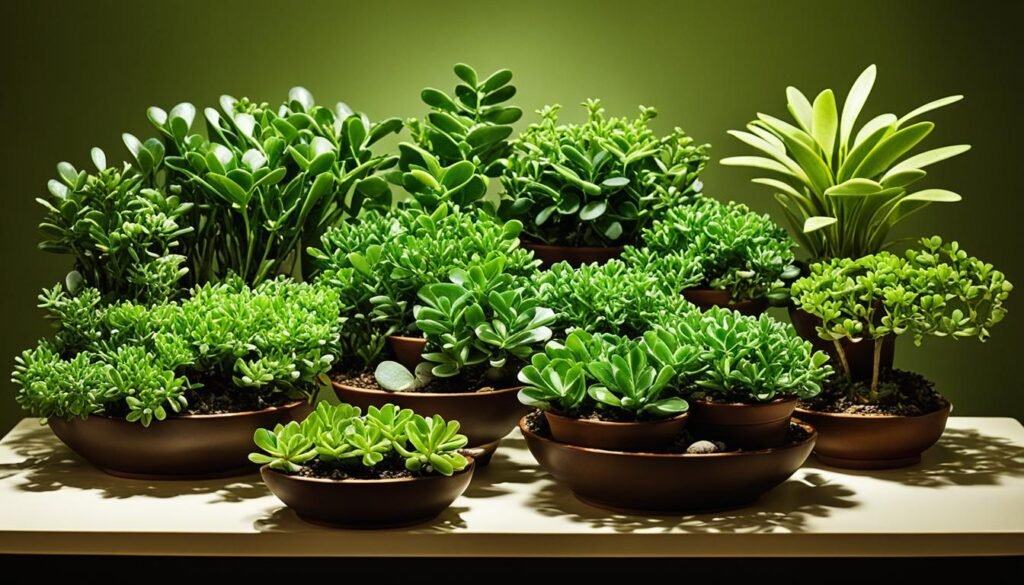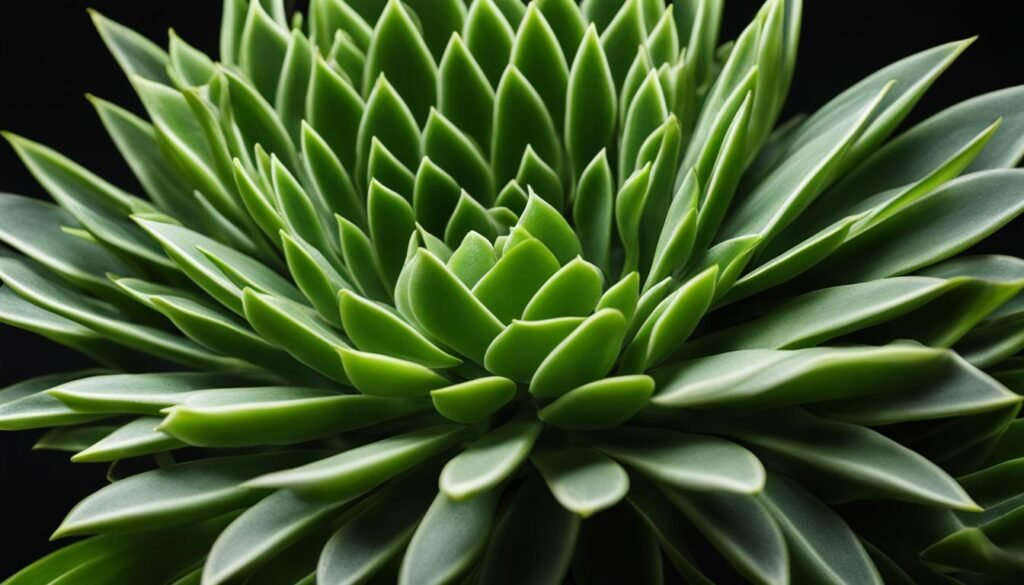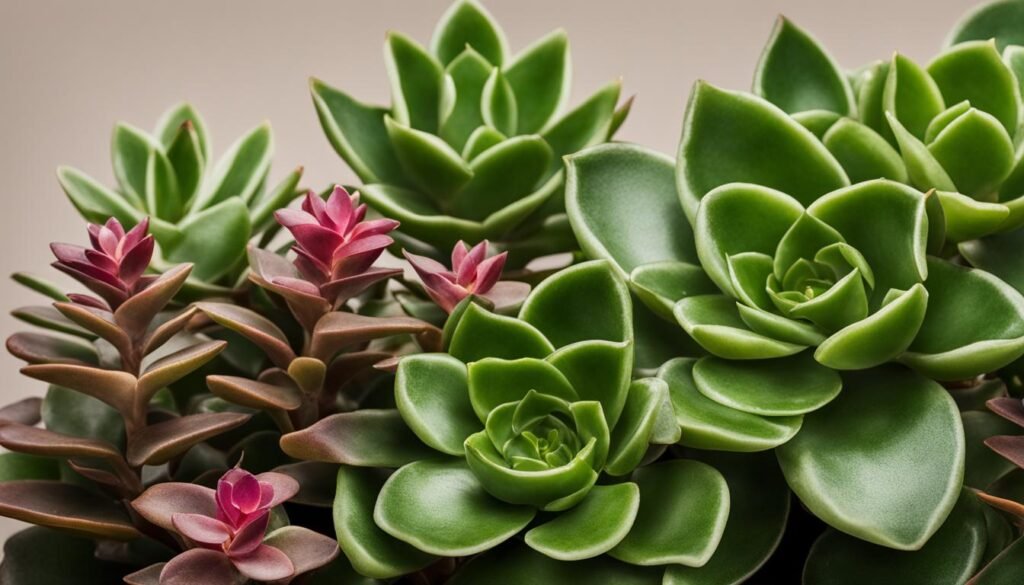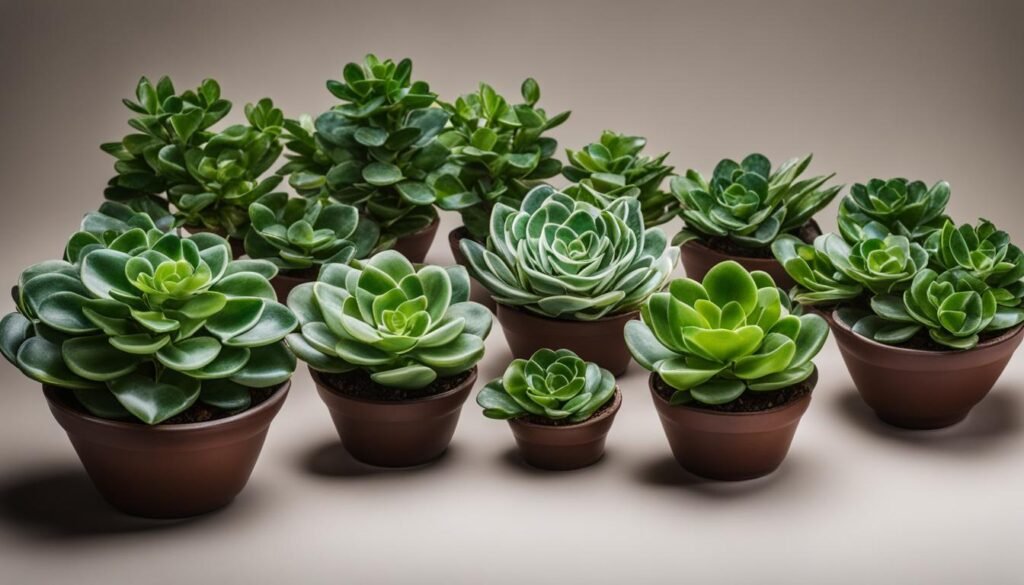If you’re searching for a low-maintenance, stunning houseplant, it’s time to consider the numerous types of jade plants available. These succulents, also known as Crassula ovata, feature thick, vibrant green leaves and are native to South Africa. With different species, cultivars, and varieties to choose from, jade plants cater to diverse preferences, suitable for various indoor gardening environments. Let’s take a closer look at the popular jade plant varieties, different types of crassula ovata, and jade plant varieties for indoor gardening to help you find the perfect addition to your indoor jungle.

Key Takeaways
- Jade plants are versatile succulents that make an excellent addition to any indoor garden.
- There are numerous types of jade plants, ranging from classic varieties to unique species and rare cultivars.
- Caring for jade plants is relatively easy, and they thrive in dry conditions with proper care and attention.
- Jade plants have different care needs based on their varieties, but they all share similar characteristics.
- A jade plant is an excellent plant for decorating and can even bring positive energy and good fortune to your household.
Understanding Jade Plants: A Brief Overview
Before exploring the different types of jade plants, let’s take a closer look at these unique succulents. Jade plants, also known as Crassula ovata, are native to South Africa and belong to the Crassulaceae family. They are known for their thick, fleshy leaves and sturdy branches, making them exceptionally resilient to drought conditions.
Although all jade plants share similar characteristics, different species and varieties offer unique features that cater to various preferences and gardening environments. Some common types of jade plants include:
- Crassula ovata ‘Jade’
- Crassula ovata ‘Gollum’
- Crassula ovata ‘Hobbit’
- Crassula ovata ‘Sunset’
- Crassula ovata ‘Tricolor’
These and many other jade plant varieties are widely available, and each has distinct characteristics that make them a pleasure to care for and admire.
To give you a better idea of what these beautiful plants look like, here’s an image of a lush and thriving jade plant:
Classic Jade Plant Varieties
The world of jade plants offers a variety of plant species to satisfy different preferences and gardening environments. One of these is the classic jade plant, revered for its iconic appearance and simple care.
The Crassula ovata ‘Jade’ is one such variety, known for its oval-shaped leaves and sturdy branches. Its dark green foliage makes it a perfect complement to any indoor garden, and it’s one of the most popular types of jade plants.
Another classic variety of jade plant is the Crassula ovata ‘Gollum.’ This unique cultivar is characterized by tubular leaves that resemble chubby fingers. Its unique and quirky appearance makes it a favorite among succulent enthusiasts, and it’s also a popular choice for indoor gardening.
These classic jade plant varieties are not only visually appealing but also easy to care for and widely available. They make fantastic additions to any indoor garden and can be mixed and matched with other jade plant species and varieties for a beautiful and varied collection.
Unique Jade Plant Species
If you’re looking for something different, consider exploring the unique jade plant species. These species have distinct characteristics that set them apart from classic varieties, adding a refreshing twist to your indoor garden.
Crassula ovata ‘Hobbit’
The Crassula ovata ‘Hobbit’ is a fascinating species that stands out with its twisted leaves resembling flower petals. With a compact growth habit and small leaf size, it makes a perfect addition to small planters and fairy gardens. The ‘Hobbit’ variety is known for its vigorous growth and ability to thrive in low-light environments, which makes it ideal for indoor gardening.
Crassula ovata ‘ET’s Fingers’

Another unique jade plant species is the Crassula ovata ‘ET’s Fingers,’ identified by its long, tubular leaves with red tips resembling alien fingers. This distinctive feature gives the cultivar a sci-fi vibe and makes it a popular choice for collectors. The ‘ET’s Fingers’ variety is easy to care for and can tolerate low humidity and drought, making it an excellent choice for novice gardeners.
Jade Plant Varieties for Indoor Gardening
When it comes to indoor gardening, choosing the right plant varieties is crucial for success. Jade plants are not only low-maintenance, but they also offer a range of stunning options that are ideal for indoor growing environments. Let’s take a look at some of the most popular jade plant varieties that thrive indoors:
Crassula ovata ‘Sunset’
The Crassula ovata ‘Sunset’ boasts variegated leaves with a mix of green and yellow hues that add a pop of color and vibrancy to any indoor space. A great feature of this variety is that it can tolerate low light, meaning you don’t have to worry about finding a spot with direct sunlight.
Crassula ovata ‘Tricolor’
If you’re looking for a jade plant with a bit more color, the Crassula ovata ‘Tricolor’ might be the perfect choice. Its green, cream, and pink leaves make for an eye-catching display that brings life to any room. This variety prefers bright, indirect sunlight and moderate watering.
These jade plant varieties are just a few options that can thrive indoors. With their easy-care nature and ability to add natural beauty to your home or office, it’s no wonder they’re a popular choice for indoor gardening enthusiasts.
Rare and Exotic Jade Plant Cultivars
If you’re a jade plant collector, you might want to add something unique to your collection. Rare and exotic jade plant cultivars are highly valued by plant enthusiasts all over the world. The Crassula ovata ‘Hummel’s Sunset’ is a beautiful cultivar that displays stunning orange and red leaves during summertime. This cultivar’s colorful foliage will undoubtedly add a touch of brightness to your indoor garden, making it look more vibrant and lively.
Another rare jade plant cultivar to consider adding to your collection is the Crassula ovata ‘Silver Dollar.’ Its striking silver-gray leaves have earned it the nickname “money plant.” If you display it prominently, it can instantly become a conversation starter. Its unique coloring adds an element of elegance and sophistication to any indoor garden.
Take your collection to the next level by adding these rare and exotic jade plant cultivars and impress your friends and family with their magnificent beauty.

Must-Know Tips for Jade Plant Care
Regardless of the type of jade plant you have, proper care is essential for their growth and overall health. Here are some expert tips to help you maintain and care for your jade plants:
Watering
Jade plants are succulents, which means they can store water in their leaves and stems. As such, they don’t require frequent watering, and overwatering can be detrimental to their health. Water your jade plant only when the top inch of soil is dry to the touch. When you do water, make sure to give your plant a thorough soak, allowing the water to drain out of the bottom of the pot. The frequency of watering will depend on the humidity levels and temperature in your environment. In general, jade plants require less water during the winter months.
Lighting
Jade plants prefer bright, indirect sunlight, and they can become scorched if exposed to direct sunlight for too long. Place your jade plant near a bright window, but avoid placing it in a spot that receives prolonged direct sunlight. If your plant starts to lean or stretch towards the light source, it’s an indication that it needs more light.
Temperature
Jade plants are adaptable to a wide range of temperatures. However, they prefer temperatures between 60-75°F (15-23°C). Avoid exposing your plant to sudden temperature changes, as this can cause its leaves to drop.
Soil
Jade plants require well-draining soil that has good aeration. Use a cactus or succulent potting mix or create a mix of sand, perlite, and peat moss for optimal soil conditions.
Fertilizer
Jade plants don’t require frequent fertilization, but you can use a balanced houseplant fertilizer during the growing season (spring and summer) to boost their growth. Don’t fertilize your plant during the winter months when they are dormant.
Pests and Diseases
While jade plants are generally resistant to pests and diseases, they are still susceptible to mealybugs, spider mites, and fungal infections. Check your plant’s leaves regularly for signs of infestation, and treat them promptly if necessary. To prevent pests and diseases, avoid overwatering your plant and provide proper air circulation and light.
By following these tips, you can keep your jade plants healthy and thriving for years to come. Remember to observe your plant’s specific needs, as each variety may require slightly different care.
Propagating Jade Plants: A Guide for Success
If you want to expand your jade plant collection or share their beauty with your friends and family, propagating them can be a great way to do so. Fortunately, propagating jade plants is relatively easy and can be done in various ways, such as stem cuttings, leaf cuttings, or division.
Stem Cuttings
Stem cuttings are one of the most popular ways to propagate jade plants. To do this, you’ll need to follow these steps:
- Use a clean, sharp knife or pruning shears to cut a healthy stem from your jade plant. Make the cut about 2-3 inches from the end of the stem.
- Keep the stem in a dry, shaded area for several days to allow it to form a callus. This will help prevent rot when you plant it.
- Fill a small pot with well-draining soil and insert the stem into the soil, burying about an inch of the stem and packing the soil around it.
- Water the soil lightly and place the pot in a bright, indirect light spot. Over time, the stem will begin to grow roots and eventually develop into a new jade plant.
Leaf Cuttings
Leaf cuttings are another way to propagate jade plants. This method is especially useful if you want to create multiple new plants from one leaf. Here’s how to do it:
- Choose a healthy leaf from your jade plant and use a clean knife or scissors to remove it from the stem.
- Allow the leaf to dry out for a few days to form a callus.
- Fill a small pot with well-draining soil and insert the leaf into the soil, burying about half of the leaf and packing the soil around it.
- Water the soil lightly and place the pot in a bright, indirect light spot. Over time, small plants will begin to grow from the leaf.
- Once the new plants have grown to about an inch tall, you can transplant them into their individual pots.
Division
Division is the quickest and easiest way to propagate jade plants. This method involves dividing the root ball of an existing jade plant into multiple sections and planting them in individual pots. Here’s what you need to do:
- Carefully remove the jade plant from its pot and gently separate the root ball into multiple sections.
- Fill individual pots with well-draining soil and plant each section in its own pot.
- Water each pot lightly and place them in a bright, indirect light spot. The new plants will start to grow quickly and will soon become fully established.
By using any of these propagation methods, you can increase your jade plant collection and share the beauty of these stunning plants with others.
Common Issues and Solutions for Jade Plants
Jade plants are generally hardy and can survive in a variety of conditions. However, they are not immune to issues and diseases. Here are some common problems you may encounter while caring for your jade plants:
“Overwatering is one of the most common mistakes people make when caring for their jade plants. Roots can easily rot if the soil remains damp for extended periods. It is best to let the soil dry out before watering again. Always check the moisture level of the soil using a moisture meter, or insert your finger into the soil. The soil should be dry to the touch, at least an inch below the surface before it’s time to water again.”
Pests like spider mites, mealybugs, or scales can also be troublesome for jade plants. These pests can cause damage to the leaves and lead to yellowing and stunted growth. It’s essential to monitor your jade plants regularly to detect and prevent pest infestations. Use a mild insecticide or neem oil to control the problem.
“Leaf drop can happen due to a variety of reasons such as low temperature, poor air circulation, pest infestations, or over-fertilization. If you notice yellow leaves or dropping leaves, examine the plant and its environment to identify the underlying problem. Providing optimal growing conditions and pruning yellowed or damaged leaves can help your jade plants to recover.”
By dealing with these common issues promptly, you can help keep your jade plants healthy and flourishing for years to come.
Decorating with Jade Plants
If you’re looking to add a touch of nature to your indoor space, jade plants are an excellent option. The unique shape and vibrant green color of their leaves can spruce up any room in your house. In this section, we’ll provide you with some creative ideas on how to incorporate jade plants into your decor.
Jade Plants as Focal Points
If you have a blank wall or space that needs some attention, consider using a jade plant as a focal point. You can either hang a wall-mounted planter filled with jade plants or place them on a decorative stand. Either way, the plants draw the viewer’s gaze and create an eye-catching display.

Jade Plants in Unique Planters
Another way to showcase your jade plants is by choosing unique and interesting planters. Jade plants look great in anything from vintage teacups to modern geometric holders. The unique planter accentuates the plant’s beauty and provides an opportunity to display your personality.
Jade Plants in Groupings
If you have several jade plants, consider grouping them together to create an impressive visual effect. You can create a grouping of similar plants or mix different species and varieties for a more eclectic look. Grouping jade plants can create a lush display that will add life to any room.
Jade Plants as Table Decor
Jade plants can also make great table decor. You can place them as centerpieces on your dining table or decorate side tables in your living room. You can pair the jade plant with candles, books, or other decorative items for a complete look.
Jade Plants with Lighting
Lighting can enhance the beauty and appeal of jade plants. Consider using lighting fixtures to accentuate the richness of the plants’ green leaves. You can use the light fixtures to highlight any of the previously mentioned decor setups in a beautiful way.
With these tips, you can create stunning displays and add a natural touch to any space using jade plants. Remember the size, color, and texture of jade plants make them an ideal decorative addition to any home.
Feng Shui and Jade Plants
For centuries, Chinese culture has associated jade plants with good luck, prosperity, and positive energy. According to Feng Shui, one of the key principles of Chinese philosophy, plants play a crucial role in promoting harmony and balance in our living spaces. By strategically placing jade plants around your home or office, you can harness their energy and enhance your well-being.
Where to Place Jade Plants for Feng Shui
When it comes to Feng Shui, the placement of jade plants matters. Firstly, always place them in the southeast area of your home or office, which is associated with wealth and prosperity. Secondly, avoid placing them in the bedroom or bathroom as these areas are considered unsuitable for plants. Lastly, ensure that they are well-lit and receive adequate sunlight to promote growth and vitality.
The Benefits of Jade Plants for Feng Shui
Aside from their aesthetic appeal, jade plants offer a range of benefits for Feng Shui. They are believed to attract wealth, abundance, and growth while warding off negative energy and promoting balance. Additionally, the round leaves of many jade plant varieties resemble coins, making them a popular choice for attracting financial prosperity.
“Jade is a symbol of serenity and purity.” – Unknown
Jade Plant Varieties for Feng Shui
While any jade plant can be used for Feng Shui, some varieties are believed to be particularly effective. The Crassula ovata ‘Hobbit’, also known as the “Baby Jade”, is a popular choice for promoting financial well-being. The Crassula ovata ‘Variegata’, with its variegated leaves, is said to promote harmony and balance, while the Crassula ovata ‘Gollum’ is believed to attract success and wealth.
Incorporating Jade Plants into Your Feng Shui Design
To fully harness the benefits of jade plants for Feng Shui, incorporate them into your interior design in creative ways. You can place them in decorative pots, arrange them in groups of three or nine, or even hang them from the ceiling. By experimenting with different placements and arrangements, you can create a meaningful and harmonious environment that supports your well-being.
Caring for Jade Plants: Frequently Asked Questions
As a jade plant owner, it’s essential to understand how to care for your plants to keep them healthy and thriving. Here are some frequently asked questions and expert insights to help you care for your jade plants:
What is the best potting soil for jade plants?
The ideal soil for jade plants should be well-draining and porous to prevent water from sitting too long around the roots. A mix of coarse sand, perlite, and peat moss can create the perfect soil for jade plants. Avoid using heavy, moisture-retaining soils or garden soil, as it can lead to root rot.
How often should I water my jade plant?
Jade plants are succulents that store water in their thick leaves, making them adept at surviving in dry conditions. Overwatering can be detrimental to jade plants, leading to root rot, so it’s best to let the soil dry out between watering sessions. Water your jade plant when the top inch of soil feels dry to the touch, and consider reducing watering in the winter when they enter dormancy.
What are the signs of underwatering or overwatering my jade plant?
If your jade plant is overwatered, you may notice yellowing leaves that feel soft to the touch, or mushy roots when you touch them. In contrast, underwatering can lead to wrinkled leaves or leaves falling off the plant. Keeping a balanced watering schedule is crucial to maintaining the health of your jade plant.
What light conditions do jade plants prefer?
Jade plants thrive in bright, indirect sunlight, but they can also tolerate low light conditions. Be mindful of placing them in direct sunlight, as it can scorch their leaves. If you notice your jade plant stretching towards the light, consider moving it to a brighter spot, but avoid sudden changes in lighting conditions.
How often should I fertilize my jade plant?
Jade plants require minimal fertilization, so it’s best to fertilize them sparingly. Use a balanced fertilizer once a month during the growing season (spring to summer), and skip fertilizing during the dormant phase (fall to winter). If you notice your jade plant’s growth slowing down or yellowing leaves, it may benefit from a dose of fertilizer.
How can I prevent pest infestations on my jade plant?
Common pests that can target jade plants are scale, mealybugs, spider mites, and aphids. Regularly inspect your jade plant for any signs of infestation, such as sticky residue, webbing, or visible insects. You can use organic pest control methods, such as neem oil, insecticidal soap, or alcohol sprays, to eradicate pests. Ensure to isolate the infected plant to avoid spreading to other plants.
Can I prune my jade plant?
Yes, pruning can help maintain the shape and size of your jade plant, as well as promote bushier growth and remove any dead or damaged leaves. Use a clean, sharp pair of scissors or pruning shears to make clean cuts, and avoid pruning during the dormant phase when the plant is conserving energy.
How can I tell if my jade plant needs repotting?
Jade plants prefer being root-bound, so they don’t need frequent repotting. However, if you notice roots coming out of the drainage hole, the soil drying out unusually quickly, or the plant becoming top-heavy, it may be time to repot. Only repot your jade plant in the spring when it’s actively growing, and use a pot that’s slightly larger than the current one.
Conclusion
In conclusion, jade plants are an excellent addition to any indoor garden. With their vibrant green leaves, resilience, and ability to thrive in dry conditions, they make an ideal choice for both seasoned and novice gardeners. From classic varieties to unique species and rare cultivars, there is a jade plant to meet everyone’s preference.
By following the tips outlined in this guide, you can ensure that your jade plants receive the care they need to flourish. Use your creativity to incorporate them into your home decor, and you’ll enjoy the beauty and benefits these remarkable plants bring to your living space.
Thank you for exploring the wonderful world of jade plants with us!
FAQ
What are jade plants?
Jade plants, scientifically known as Crassula ovata, are succulent shrubs native to South Africa. They belong to the Crassulaceae family and are recognized for their thick, vibrant green leaves and ability to thrive in dry conditions.
What are the different types of jade plants?
There are various types of jade plants available, including classic varieties such as Crassula ovata ‘Jade’ and Crassula ovata ‘Gollum’. Unique species like Crassula ovata ‘Hobbit’ and Crassula ovata ‘ET’s Fingers’ offer a refreshing twist. Additionally, there are rare cultivars like Crassula ovata ‘Hummel’s Sunset’ and Crassula ovata ‘Silver Dollar’ that add intrigue to any collection.
Which jade plant varieties are suitable for indoor gardening?
Indoor gardening enthusiasts can opt for jade plant varieties like Crassula ovata ‘Sunset’ and Crassula ovata ‘Tricolor’. These plants thrive well in indoor environments and add color and life to homes or offices.
How should I care for jade plants?
Proper care is essential for the growth and survival of jade plants. It includes providing adequate watering, sufficient lighting, maintaining the right temperature, and understanding other key aspects of jade plant care. We will provide you with expert tips on all these aspects in a dedicated section.
How can I propagate jade plants?
Jade plants can be propagated through various methods such as stem cuttings, leaf cuttings, and division. In a separate section, we will guide you through the step-by-step process of propagating these beautiful plants.
What are some common issues I may encounter while caring for jade plants?
Like any plant, jade plants are subject to common problems such as overwatering, pests, and leaf drop. In another section, we will address these issues and provide effective solutions to help you keep your jade plants healthy.
How can I incorporate jade plants into my home decor?
Jade plants can be used creatively in interior design, serving as focal points in room arrangements or displayed in unique planters. We will provide tips and inspiration on how to incorporate jade plants into your home decor in a dedicated section.
What is the connection between jade plants and Feng Shui?
Jade plants have long been associated with positive energy and good luck in Chinese culture. In a separate section, we will explore the concept of Feng Shui and how to strategically place jade plants to invite wealth, harmony, and good fortune into your household.
What are some frequently asked questions about jade plant care?
In the final section, we will address frequently asked questions about jade plant care. These include topics like potting soil recommendations and signs of underwatering or overwatering.